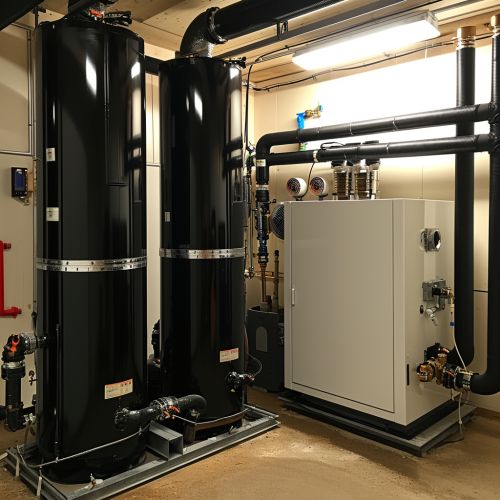Sensible heat storage
Introduction
Sensible heat storage (SHS) is a type of thermal energy storage that involves the transfer of heat to or from a storage medium without a change in phase. The term "sensible" in this context refers to the fact that the process can be sensed or measured by a thermometer, as opposed to latent heat storage where the heat transfer is associated with a phase change. SHS is a critical component in many energy systems, including solar thermal power plants, building heating and cooling systems, and industrial heat processesread more.
Principle of Operation
In a sensible heat storage system, heat is stored by raising the temperature of a storage medium. The amount of heat stored is proportional to the specific heat capacity of the medium and the temperature change it undergoes. The storage medium can be a solid, liquid, or gas, but solids and liquids are most commonly used due to their higher density and specific heat capacity. The heat can be retrieved from the storage medium by reversing the process, i.e., by allowing the medium to cool down and transfer its heat to a working fluid or another system.
Storage Media
Different materials can be used as the storage medium in a sensible heat storage system. The choice of material depends on several factors, including the operating temperature range, the specific heat capacity, the thermal conductivity, the cost, and the availability of the material.
Solids
Solid materials used for sensible heat storage include rocks, concrete, and metals. These materials have high thermal conductivity and can withstand high temperatures, making them suitable for high-temperature applications such as concentrated solar power plants. However, they also have some drawbacks, such as low specific heat capacity (compared to liquids) and potential issues with thermal expansion.
Liquids
Liquid storage media, such as water, oils, and molten salts, are commonly used in sensible heat storage systems. Water is the most commonly used liquid due to its high specific heat capacity, low cost, and environmental friendliness. However, it has a relatively low boiling point, which limits its use in high-temperature applications. Molten salts and oils can be used at higher temperatures, but they are more expensive and may have environmental and safety concerns.
Design Considerations
The design of a sensible heat storage system depends on several factors, including the type of storage medium, the operating temperature range, the desired storage capacity, and the heat transfer mechanism.
Storage Capacity
The storage capacity of a sensible heat storage system is determined by the mass of the storage medium, its specific heat capacity, and the temperature change it undergoes. To increase the storage capacity, one can either increase the mass of the storage medium, use a medium with a higher specific heat capacity, or operate over a larger temperature range.
Heat Transfer Mechanism
The heat transfer mechanism is a critical aspect of the design of a sensible heat storage system. Heat can be transferred to and from the storage medium by conduction, convection, or radiation. In most cases, conduction and convection are the primary modes of heat transfer. The design of the system should ensure efficient heat transfer to minimize heat losses and maximize the overall system efficiency.
Thermal Insulation
Thermal insulation is necessary to minimize heat losses from the storage system to the surroundings. The type and thickness of the insulation depend on the operating temperature of the system and the ambient conditions. In general, higher operating temperatures require better insulation.
Applications
Sensible heat storage systems have a wide range of applications, including power generation, building heating and cooling, and industrial processes.
Power Generation
In power generation, sensible heat storage systems are used to store excess heat produced during periods of high electricity demand for use during periods of low demand. This can help to smooth out fluctuations in electricity supply and demand and improve the overall efficiency of the power plant.
Building Heating and Cooling
In buildings, sensible heat storage systems can be used to store heat produced during the day for use at night, or vice versa. This can help to reduce the energy consumption of the building and improve its thermal comfort.
Industrial Processes
In industrial processes, sensible heat storage systems can be used to store waste heat for later use. This can help to reduce the energy consumption of the process and decrease its environmental impact.
Advantages and Disadvantages
Like any other technology, sensible heat storage has its advantages and disadvantages.
Advantages
One of the main advantages of sensible heat storage is its simplicity. The technology is well understood and can be implemented using readily available materials and equipment. Sensible heat storage systems also have high energy density, especially when using liquid storage media, and can operate over a wide range of temperatures.
Disadvantages
One of the main disadvantages of sensible heat storage is the relatively low storage efficiency, especially when compared to latent heat storage or thermochemical storage. This is due to the fact that the amount of heat stored is proportional to the temperature change of the storage medium, which is typically limited to prevent material degradation. Another disadvantage is the potential for significant heat losses, especially in high-temperature applications, which require good thermal insulation.
Future Developments
Research and development efforts in the field of sensible heat storage are focused on improving the efficiency and cost-effectiveness of the technology. This includes the development of new storage media with higher specific heat capacities and thermal conductivities, the optimization of system designs to minimize heat losses and maximize heat transfer, and the integration of sensible heat storage systems with other energy technologies to create more efficient and sustainable energy systems.
See Also


